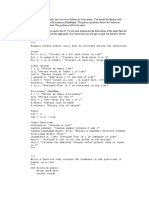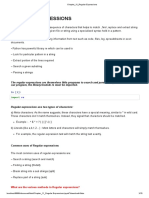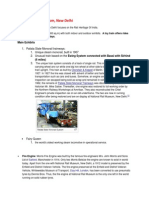For Numeric Textbox, Alphabetic Textbox N Regular Expression Symbol
Uploaded by
Angates1For Numeric Textbox, Alphabetic Textbox N Regular Expression Symbol
Uploaded by
Angates1For alphanumeric textbox
Private Sub txtfindWhat_TextChanged(ByVal sender As Object, ByVal e As System.EventArgs) Handles txtfindWhat.TextChanged Dim sText As String Dim cInvalidChars() As Char = {"~", "`", "!", "@", "#", "$", "%", "^", "&", "*", "(", ")", "_", "-", "=", "+", "{", "[", "}", "]", "|", "\", ":", ";", """", "'", "<", ",", ">", ".", "?", "/"} Dim iIndex As Integer sText = txtfindWhat.Text iIndex = sText.IndexOfAny(cInvalidChars) 'All valid chars If (iIndex = -1) Then Return 'Remove invalid char txtfindWhat.Text = sText.Remove(iIndex, 1) 'Put the cursor back on the last pos txtfindWhat.SelectionStart = txtfindWhat.Text.Length End Sub
For numeric textbox
Private Sub TextBox1_KeyPress(ByVal sender As System.Object, ByVal e AsSystem. Windows.Forms.KeyPressEventArgs) Handles TextBox1.KeyPress If (e.KeyChar < Chr(48) Or e.KeyChar > Chr(57)) And e.KeyChar <> Chr(8) Then e.Handled = True MessageBox.Show("Please enter only number") End If End Sub End Class
Regular expression symbols
SYMBOL \ . ^ NAME backslash period carat DESCRIPTION Turn off the special meaning of the next character, as in \^. Match a single character of any value, except end of line. Match the start of the line, as in ^A.
$ | [] [^]
dollar sign pipe square brackets carat enclosed in square brackets parentheses exclamation point question mark asterisk plus n enclosed in braces n, enclosed in braces ,n enclosed in braces n,m enclosed in braces
Match the end of the line, as in A$. Match either the regular expression preceding it or the regular expression following it. Match any single character from within the bracketed list, as in [abcde]. Use a hyphen (-) for a range, as in [0-9]. Within square brackets, most characters are interpreted literally. Match any single character except those within the bracketed list, as in [^0-9]. Group one or more regular expressions to establish a logical regular expression consisting of sub-regular expressions. Used to override the standard precedence of specific operators. Do not match the next character or regular expression. Match 0 or 1 time. Match 0 or more times. Match 1 or more times. Match exactly n times. Match n or more times. Match n or fewer times. Match at least n times but not more than m times.
() ! ? * + {n} {n,} {,n} {n,m}
For alphabetic textbox only
1. Private Sub textDate_KeyPress(ByVal sender As Object, ByVal e As
System.Windows.Forms.KeyPressEventArgs) Handles textDate.KeyPress
2. If (Microsoft.VisualBasic.Asc(e.KeyChar) < 65) _ 3. Or (Microsoft.VisualBasic.Asc(e.KeyChar) > 90) _ 4. And (Microsoft.VisualBasic.Asc(e.KeyChar) < 97) _ 5. Or (Microsoft.VisualBasic.Asc(e.KeyChar) > 122) Then 6. 'space accepted 7. If (Microsoft.VisualBasic.Asc(e.KeyChar) <> 32) Then 8. e.Handled = True 9. End If 10. End If 11. If (Microsoft.VisualBasic.Asc(e.KeyChar) = 8) Then 12. 13. e.Handled = False 14. End If 15. End Sub
You might also like
- Regular Expressions: Regular Expression Syntax in PythonNo ratings yetRegular Expressions: Regular Expression Syntax in Python11 pages
- BlazeMeter Test Data Fundamentals Synthetic ExamplesNo ratings yetBlazeMeter Test Data Fundamentals Synthetic Examples8 pages
- How To Write Regular Expressions?: What Is A Regular Expression and What Makes It So Important?No ratings yetHow To Write Regular Expressions?: What Is A Regular Expression and What Makes It So Important?2 pages
- Applications of Regular Expressions: BY - Nikhil Kumar KatteNo ratings yetApplications of Regular Expressions: BY - Nikhil Kumar Katte16 pages
- Statistics With R Programming For Bigdata (Autosaved)No ratings yetStatistics With R Programming For Bigdata (Autosaved)41 pages
- Raunakmalkani 20BIT032 Assignment RegularExpressionsNo ratings yetRaunakmalkani 20BIT032 Assignment RegularExpressions14 pages
- Manipulating Text with Regular Expression in pythonNo ratings yetManipulating Text with Regular Expression in python4 pages
- Python Assignment 7 String by Hemanth Raj S Civil s01No ratings yetPython Assignment 7 String by Hemanth Raj S Civil s017 pages
- 1 ICS 2175 Lecture 5 Strings and ArraysNo ratings yet1 ICS 2175 Lecture 5 Strings and Arrays23 pages
- Staff Selection Commission: Registration Number 92000511055No ratings yetStaff Selection Commission: Registration Number 920005110553 pages
- Simulations in PSPICE For Circuit Analysis of Semiconductor DevicesNo ratings yetSimulations in PSPICE For Circuit Analysis of Semiconductor Devices14 pages
- Entrepreneur From Iits, Iims, FMS, Xlri and University of DelhiNo ratings yetEntrepreneur From Iits, Iims, FMS, Xlri and University of Delhi13 pages
- I, Registration/admission/enrolment Number, Having Been Admitted ToNo ratings yetI, Registration/admission/enrolment Number, Having Been Admitted To2 pages
- 3610-Dynamic URL and Action For SOAP Receiver Communication Channel PDFNo ratings yet3610-Dynamic URL and Action For SOAP Receiver Communication Channel PDF26 pages
- THE ROLE OF PRODUCT KNOWLEDGE AND KNOWLEDGE MANAGEMENT IN THE IMPLEMENTATION OF COPPERNo ratings yetTHE ROLE OF PRODUCT KNOWLEDGE AND KNOWLEDGE MANAGEMENT IN THE IMPLEMENTATION OF COPPER20 pages
- Technical Interview Questions in OracleNo ratings yetTechnical Interview Questions in Oracle10 pages
- Implementation of Medical Image Fusion Using DWT Process On FPGANo ratings yetImplementation of Medical Image Fusion Using DWT Process On FPGA4 pages
- Chapter 5 (Magnetism and Matter) Unsolved PDFNo ratings yetChapter 5 (Magnetism and Matter) Unsolved PDF4 pages
- Probability and Statistics & Complex VariablesNo ratings yetProbability and Statistics & Complex Variables37 pages
- Multileaf Collimators: Rina Taurisia Medical Physicist MRCCC Siloam Hospitals100% (1)Multileaf Collimators: Rina Taurisia Medical Physicist MRCCC Siloam Hospitals28 pages
- How To Make DIFFICULT Choices by Gaur Gopal DasNo ratings yetHow To Make DIFFICULT Choices by Gaur Gopal Das4 pages







































































































